Ali-Sadr Cave | Largest Water Cave in the World
Caves are like ancient vaults of the planet's history, cradling untold stories and preserving the echoes of time between their walls. Each is a unique narrative and a silent witness to past eons.
But among these enigmatic sanctuaries, Ali Sadr Cave stands out as one of the world's rarest and largest water caves, attracting thousands of visitors annually.
Ali Sadr Cave boasts an array of geological marvels that will leave any visitor in awe. Stalactites and stalagmites, formed over millennia, hang like natural chandeliers while shimmering pools and mysterious chambers beckon you deeper into the heart of this underground wonderland.
Ali Sadr Cave is nothing short of a miracle crafted by Mother Nature herself. It's not just a destination; it's an invitation to embark on an otherworldly adventure. Follow us as we embark on an extraordinary journey to explore the history, structures and location of this subterranean masterpiece. Be prepared to be spellbound by its wonders!
About Ali Sadr Cave
Ali Sadr Cave is located in Hamedan province on Sarighieh Heights near Alisadr village. In 2008, it was officially registered as Iran's 23rd natural monument by Iran's Cultural Heritage Organization.
Ali Sadr cave reaches a staggering height of 2100 meters above sea level. Inside Ali Sadr Cave, visitors are mesmerized by its intricate network of winding cave halls and captivating cave atriums.
In addition, there are two other caves by the names of Soo Bashi and Sarab Caves near Ali Sadr Cave, and the water in Alisadr Cave takes its source from that of the Sarab Cave, giving the cave a distinctive feature of a pool of water, which creates a serene and enchanting atmosphere inside the cave.
History of Ali-Sadr Cave
The history of Ali Sadr Cave is a fascinating tale of ingenuity, natural wonders, and human exploration. Located in the hills, the cave is accompanied by two other caves known as Soo Bashi and Sarab Caves. The water within Ali Sadr Cave originates from Sarab Cave.
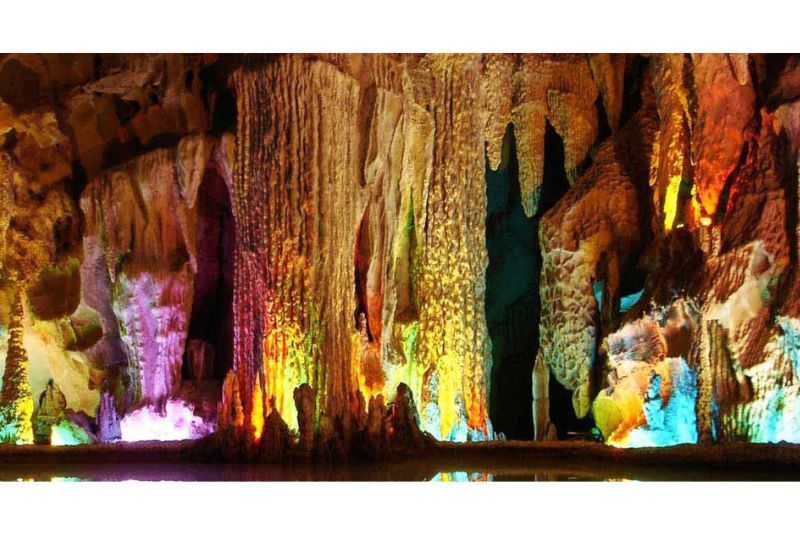
The geological origins of the Alisadr cave can be traced back to the 2nd geological period, dating approximately 136-190 million years ago. The local villagers recognized the value of the cave's water and devised a brilliant solution to utilize it during the summer and hot weather. They ingeniously diverted excess water from Sarab Creek into Ali Sadr Cave, effectively transforming it into a reservoir. The water level rose to an impressive 2.20 meters near the cave's entrance, temporarily blocking access.
However, in 1957, an earthquake caused a significant crack to open in Sarab Cave, halting the flow of water from Sarab Creek into Ali Sadr Cave. It took six years for the water level in Ali Sadr Cave to normalize, restoring access once again. This event marked a turning point as mountaineers and mountain climbers seized the opportunity to explore the depths of the cave.
In 1963, a group of 14 mountain climbers from Hamedan conducted the first professional excavations in Ali Sadr Cave. Their efforts contributed to our understanding of the cave's geological and historical significance. Up until 1973, the cave's opening was a mere 50 centimeters wide, limiting access to professional climbers. However, in that year, Abdullah Hajiloo, with the help of local residents and the mountaineering committee, successfully widened the opening to 5 meters and increased its height to 3 meters. The following year, a concrete path was constructed, allowing visitors to explore a section of the cave on foot.
By 1976, Ali Sadr Cave was equipped with boats and lighting facilities, making it accessible to ordinary people and tourists. Printed entry tickets were introduced and managed by Hamedan's Physical Education organization, officially opening the cave to the public.
While approximately 2,100 meters of the cave's canals have been explored so far, it is believed that there are still undiscovered passages waiting to be explored.
| Discover: Famous Caves of Iran
Origin of the Name "Ali Sadr"
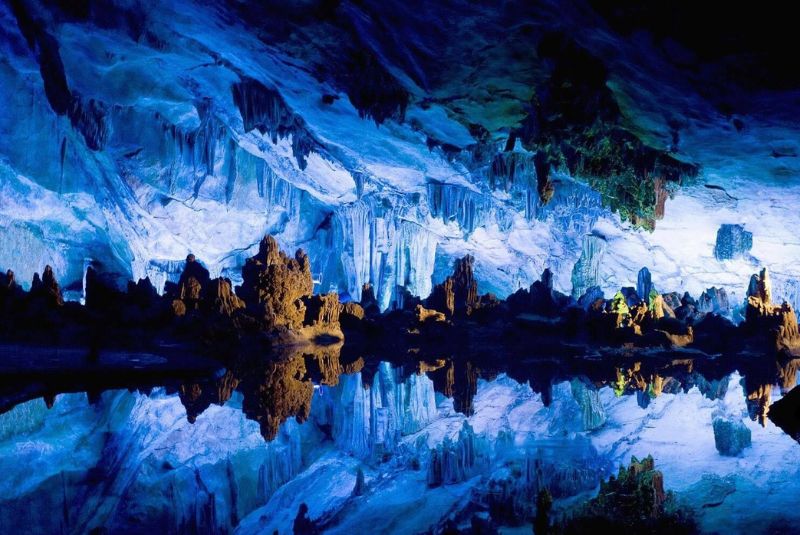
The origin of the name "Ali Sadr Cave" is intertwined with the historical usage of the cave as a water reservoir and a series of administrative decisions. Initially, the village's name was officially registered as "Ali-Sard," with "Sard" translating to "Cold" in English due to its association with the cave's function as a dam and reservoir.
However, in 1971, during the construction of the village's road, the executive contractor decided to use the name "Ali-Sadr" for the project. This name gradually gained popularity and became commonly used for both the village and the cave. Today, the name "Ali Sadr" is widely recognized and used by locals and visitors alike, although the village's original name was "Ali-Sard."
| Suggestion: Hormuz Salt Goddess Cave + Photos
Features of Ali Sadr Cave
Ali Sadr Cave is an extraordinary underground marvel renowned for its well-organized structure and captivating features. The cave is a complex network of interconnected halls and passages, creating a mesmerizing labyrinth-like maze.
The cave's ceiling height ranges from 1 to 35 meters, while the canal widths vary from 2 to 15 meters. The water depths within the cave fluctuate between 1 to 17 meters, adding to the diverse and enchanting environment.
The cave's ceiling is adorned with layers of pure calcium carbonate and other chemical compounds, resulting in stunning stalagmites that showcase unique and intricate designs, leaving visitors in awe.
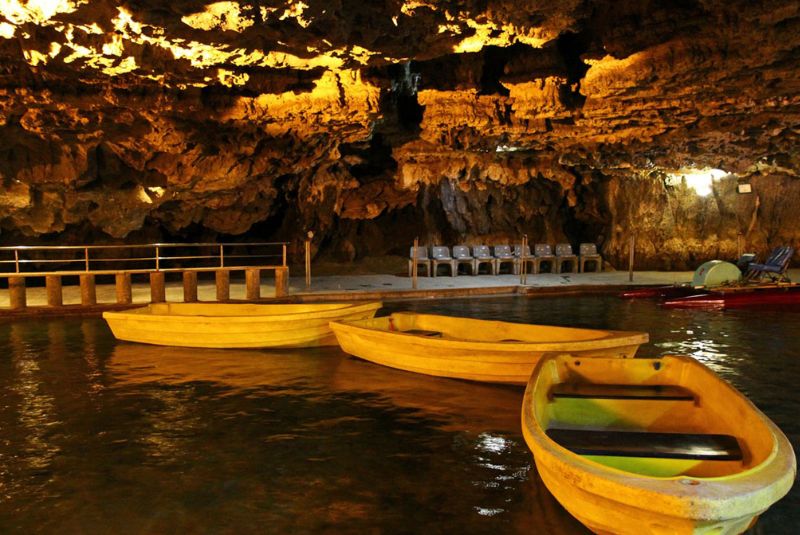
The cave also houses chambers with towering ceilings resembling grand concert halls, while other regions feature lower ceilings that require visitors to bend their necks. One notable chamber is the "Freedom Hall," the largest chamber in Ali Sadr Cave, stretching an impressive 100 meters wide. Another mesmerizing sight is the "Wedding Chamber," adorned with thousands of small white crystals formed by stalactites, creating a breathtaking spectacle.
Alis Sadr cave is also equipped with electric power and canoes capable of accommodating four people, allowing visitors to navigate the waterways and facilitate exploration.
Ali Sadr Cave also features an expansive lake, offering the opportunity for boating through its deeper sections. The lake's water originates from underground springs and seepage from the cave's walls and ceilings, creating a serene and picturesque setting. In addition to the awe-inspiring sights, the cave boasts clean and fresh air, devoid of pollution and dust. Its temperature remains cool during summer and mild in winter, so you should plan your attire accordingly.
| Read more: Quri Qaleh Cave + Photos
The Best Time to Visit Ali Sadr Cave
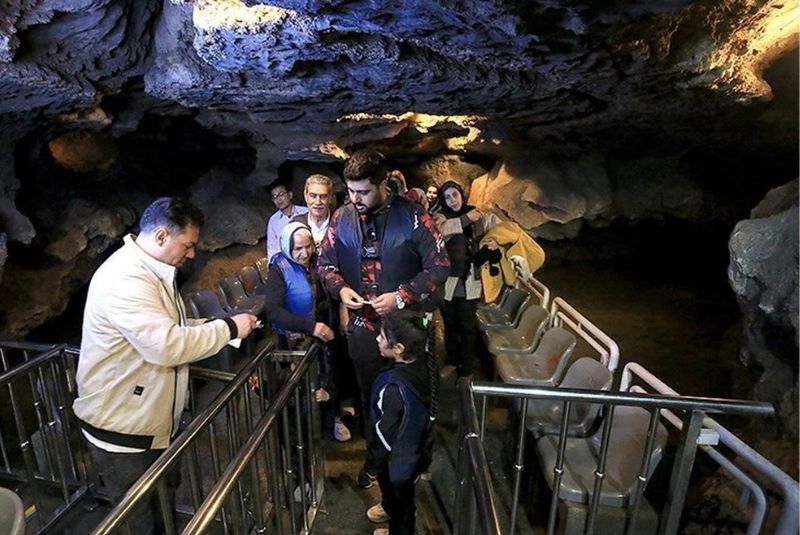
If you're planning to visit the enchanting Alisadr Cave in Hamedan, it's important to consider the best time to travel and the routes to reach your destination. Hamedan, being a mountainous city, is most enjoyable to explore from mid-May until October when the weather is pleasant. As caves tend to have cooler temperatures compared to the outside, it's advisable to bring a jacket along in case it gets a little chilly inside.
| Also read about: Chahkooh Canyon, Qeshm Island + Photos
How to Get to Alisadr Cave
To reach Alisadr Cave, the new Lalejin-Bijar road is the recommended route. This road is newly constructed and offers a safe driving experience, especially during high seasons when the traffic is heavy. Alternatively, there are two other routes you can take: the Hamedan to Saleh-Abad road and the Hamedan to Razan road. These routes may provide different scenery and experiences along the way.
| Check out our Iran tour packages to find the best package that suits you!
Or... get in touch to tailor your own itinerary!
Location of Ali Sadr Cave
Ali Sadr Cave is situated in Kabudrahang City, located outside of Hamedan. This picturesque city is positioned between Hamedan and Zanjan, but it is notably closer to Hamedan than to Zanjan.
Where to Stay When Visiting Ali Sadr Cave
When planning your visit to Ali Sadr Cave, you have options for where to stay that cater to different preferences. Hamedan offers a range of hotels for accommodation. Whether you prefer the convenience and amenities of a city hotel or want to experience the charm of Hamedan, staying in the city is a viable choice.
Alternatively, you have the option to stay near Ali Sadr Cave itself, allowing you to immerse yourself in the natural beauty of the surrounding area. By staying nearby, you can enjoy the tranquility and scenic landscapes for a more immersive experience. There are accommodations available in the vicinity of the cave that cater to visitors.
For a seamless travel experience, we can assist you with all the necessary arrangements, from Iran visa services to hotel bookings and more. We can also offer various Iran tour packages that can be tailored to include Ali Sadr Cave and other desired destinations.
| Discover: Shirez Canyon
Where to Eat Near Ali-Sadr Cave
When visiting Ali Sadr Cave, there are several nearby restaurants where you can enjoy a meal before or after your exploration. Some options to consider include Pizza Tourist Cave, Nouri Restaurant, Anadana Restaurant, Bahar Restaurant, Pardis Restaurant, Sarcheshme Restaurant, and Ariana Restaurant.
| Suggestion: Persian Food
Factors to Consider When Visiting Ali Sadr Cave
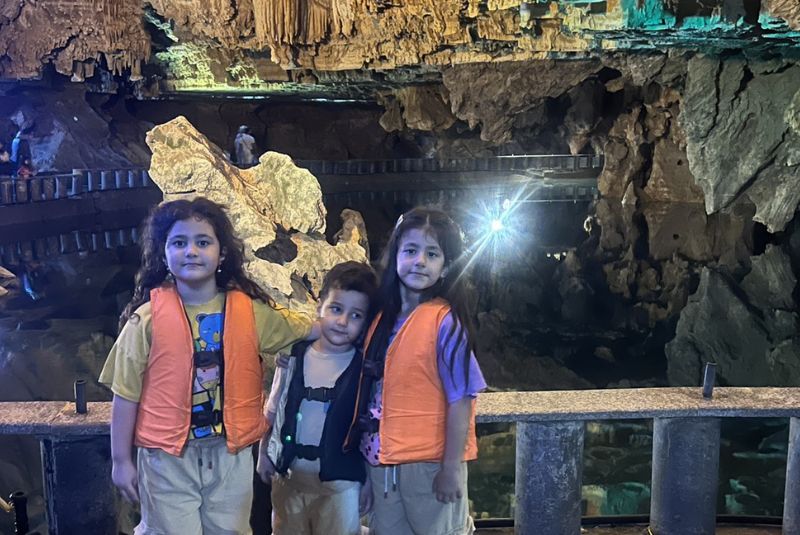
Before visiting Ali Sadr Cave, there are several important factors to consider. Here are some key points to keep in mind:
- Temperature: The cave maintains a constant temperature, with the air averaging around 16 degrees Celsius and the water at approximately 12 degrees Celsius.
- It's advisable to dress accordingly to ensure comfort during your visit.
- pH and Water Depth: The cave's water has an almost neutral pH level. The depth of the water can vary between 0.5 to 14 meters, so it's essential to be cautious and follow any safety guidelines provided.
- Water Hardness: The water in Ali Sadr Cave has high hardness due to the presence of lime. It is not suitable for drinking, so it's important to refrain from consuming the water within the cave.
- Air Quality: Fortunately, The Ali Sadr cave is a live cave, meaning there is a natural flow of air, ensuring no shortage of breath or presence of poisonous gasses. So, feel free to explore the cave comfortably without any respiratory concerns.
- Stability of the Cave: Ali Sadr Cave is of the consolidated type, which means that there haven't been any rock falls in the past five million years. So Ali Sadr cave is a safe cave for visitors to explore and admire the ancient formations.
Quick Facts about Ali Sadr Cave
Here are some quick facts about the remarkable Ali-Sadr Cave, organized for easy reading:
- Ali-Sadr Cave holds the title of being the longest water cave globally.
- It is renowned as the most well-known cave in Iran.
- The cave has a total length of 11,200 meters, but only 2,400 meters are open for visitors to explore.
- Ali Sadr cave is situated at an altitude of 2,100 meters above sea level.
- It is considered one of the world's largest canoeing caves, providing ample space for boating adventures.
- Ali-Sadr cave is classified as an ancient and living cave with an age of 190 million years.
- The only living creature in Ali Sadr's waters is the Ali-Sadr Niphargus.
- Ali-Sadr cave is a natural formation, not a man-made structure.
- The water depth in the cave varies from a mere 4 centimeters to an impressive 14 meters.
- The cave's water is colorless and odorless.
- The water maintains a constant temperature of 12 degrees Celsius throughout the year.
- The maximum height from the lake to the cave's ceiling reaches an astounding 54 meters, equivalent to an 18-story building.
Bottom Line
Ali Sadr Cave is a captivating and dynamic natural wonder that continues to evolve beneath the earth's surface. Its ever-changing formations, influenced by minerals in the dripping water, make it a living phenomenon worth exploring.
The cave's ancient history, majestic beauty, and unique boating experience on an underground lake add to its allure. Notably, Ali Sadr Cave is currently under consideration for inclusion in UNESCO's World Heritage Centre as a significant site in Iran.
Ali Sadr Cave offers visitors an extraordinary opportunity to witness nature's marvels and explore its breathtaking features. From the interconnected halls and passages that form a labyrinth-like maze to the expansive lake, every aspect of the cave leaves a lasting impression. Contact us to plan your trip and enjoy a seamless and enjoyable experience while visiting Ali Sadr Cave and other captivating destinations in Iran.
Share your story!
Comment below and let us know about your Experience.
Your story inspires others!


Comment
Leave a Comment